Mopping up
Clean house with this cold-water killer
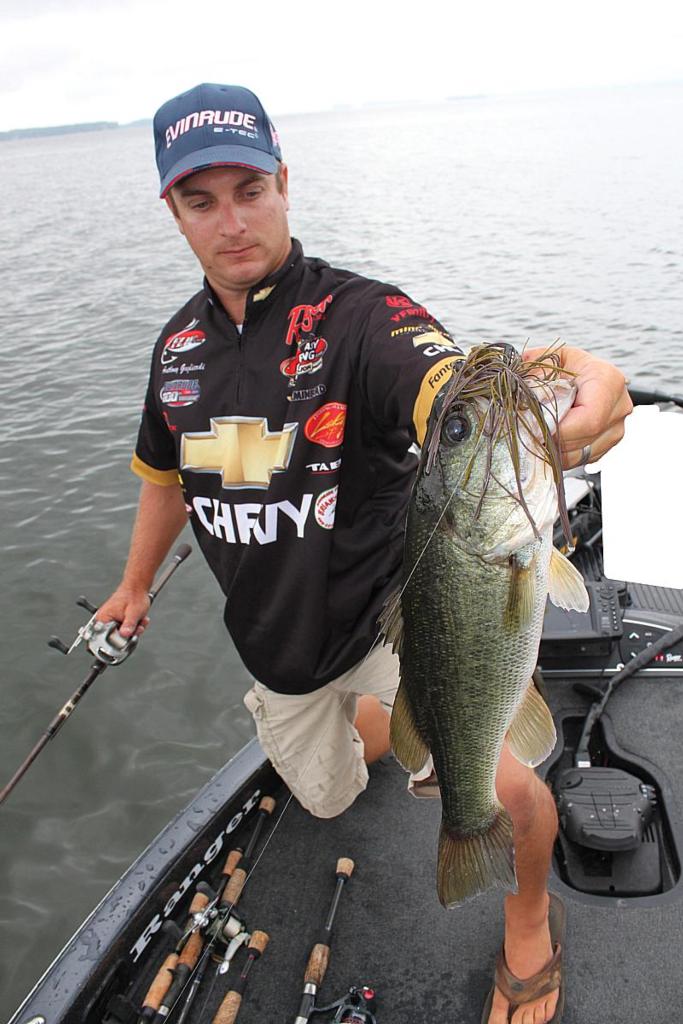
————————————–
Editor’s note: For only $8, you can get a one-year subscription to the online edition of either FLW Outdoors Magazine or Walleye Magazine, including all the great articles and photos included in the print editions plus enhanced content like videos and much more (free preview of FLW e-Magazine). That same $8 also gets you a Player’s Advantage membership for FLW Fantasy Fishing and discounts on FLW merchandise and other products and services.
————————————–
The mop-style jig notched its first big-money victory at Lake Murray on a chilly day in February 2006. Spring weather had been trying to break out early in the Carolinas that year, and a string of warm days had pulled a lot of fish shallow. Tournament week marked the return of bone-chilling cold, however, and by the time the Walmart FLW Tour event began many bass were retreating back to deeper water.
The script suited Chevy pro Anthony Gagliardi just fine. Gagliardi, who makes his home at Lake Murray, knew the fish were in cold-water prespawn mode. Bass would be scattered due to the up-and-down spring temperatures, and they would be hunting for calorie-packed meals that didn’t require much work. That dovetailed nicely with a strategy that was then still regionally contained in South Carolina: dragging a “heavy rubber” jig very slowly across the bottom.
Gagliardi, who ended up winning that event, employed a handful of tactics. However, it was his big rubber-skirted jig – the same style of jig that would soon be popularized by Buckeye Lures as the Mop Jig – that produced all of his largest bass and the majority of the fish that he weighed in. Since then, Gagliardi and other Carolina pros have helped spread the news about the effectiveness of the mop-style jig throughout the country. Its unique skirt design has made it a springtime staple.
The jig
Hand-tied jigs that utilize “heavy rubber” have been locally popular in the Carolinas and Georgia for 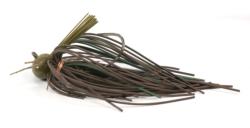 years. The Buckeye Mop Jig boosted big rubber into mainstream tournament fishing and created the new lure category of mop-style jigs. The Buckeye model was originally introduced simply as the Pro Jig, but was renamed the Mop Jig – as the story goes – after Kevin VanDam told Davy Hite (who, like Gagliardi, lives on Lake Murray) during a tournament that his big jig looked like a mop. Hite’s response was to win the event with the jig.
years. The Buckeye Mop Jig boosted big rubber into mainstream tournament fishing and created the new lure category of mop-style jigs. The Buckeye model was originally introduced simply as the Pro Jig, but was renamed the Mop Jig – as the story goes – after Kevin VanDam told Davy Hite (who, like Gagliardi, lives on Lake Murray) during a tournament that his big jig looked like a mop. Hite’s response was to win the event with the jig.
The jig’s long rubber skirt strands create a flowing look in the water when fished at slow speeds, an action that other skirt materials can’t mimic.
Heavy rubber
Rubber skirt material ranges in diameter, but only thick or “heavy” rubber works for creating the bulk and larger-than-life profile that define mop-style jigs. Both flat and round rubber will do the job, and each has its advocates among anglers who tie their own. The important thing is that thick material is used. Here is where to find it on the Internet:
– Living Rubber Company (livingrubber.com) currently offers only round rubber. It comes in 15-foot-long pieces or by the pound, which amounts to about 54 feet. The rubber then has to be cut into strands and made into skirts by those who tie their own jigs. Forming a skirt first with a rubber skirt band and then securing it to a jig-hook with wire is a little easier than tying the strands directly.
– Skirts Unlimited Inc. (fishingskirts.com) makes flat-rubber skirt material in 1 1/2-inch tabs that are 5 1/2 inches long and pre-divided to be split into 22 strands. The tabs are easier to work with than individually cut strands.
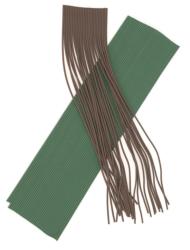 – Longer, wider flat-rubber strands don’t appear to be in production anywhere at present and are only randomly available when someone sells some on eBay or elsewhere.
– Longer, wider flat-rubber strands don’t appear to be in production anywhere at present and are only randomly available when someone sells some on eBay or elsewhere.
The profile
Whether the jig is falling through the water column or being dragged steadily along, the main difference between a mop-style and most other styles is the size of the profile. Most mop-style jigs have long, billowy strands that create the illusion of a large fish or crayfish. Other than that, the rubber skirt doesn’t move much differently than a silicone skirt.
The time when a mop-style jig skirt really stands out from the crowd, however, is when the jig stops moving.
“The best way I can think of to describe it is that it looks like a jellyfish that puffs out,” Gagliardi says. “The rubber keeps moving for much longer than you would think as the skirt balloons out and then eventually returns to its collapsed position.”
Some mop-style jig skirts actually don’t contract at all, such as the Talon Shibui Ookii Jig; instead, its skirt stays flared and looks like clumps of flowing weeds with trailers hidden within them.
Speaking of trailers, since a big profile is the normal objective, trailers tend to be big as well. Gagliardi 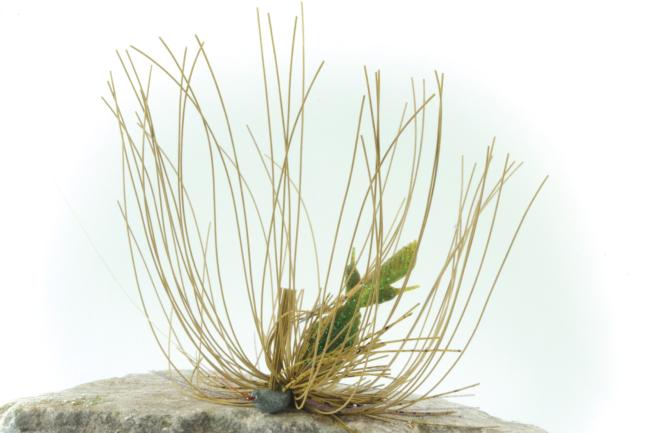 prefers a 3-inch chunk-style trailer for dragging; the same size in a craw-type for flipping.
prefers a 3-inch chunk-style trailer for dragging; the same size in a craw-type for flipping.
When and where it excels
The mop-style jig built its regional following in the Deep South as a cold-water tool that is ideally suited for the type of bass Gagliardi targeted when he won at Lake Murray. These are lethargic, slow-moving fish relating to deeper structure. They’re unwilling to chase anything, but that doesn’t mean they’ll pass up easy protein.
“Bass see that big profile, and it is slow-moving, so they don’t have to expend a lot of energy to eat it,” Gagliardi says.
From the dead of winter to the prespawn period is Gagliardi’s favorite time to drag a Mop Jig, although he also likes to use it for postspawn fish on certain lakes. He has heard of anglers using mop-style jigs with good success for summer structure fishing and at other times. The key is that the fish need to be relating to the bottom and hanging tight to specific pieces of structure, unwilling to move far.
“A lot depends on the lake,” Gagliardi says. “For whatever reason, there are certain lakes where the Mop Jig really shines. It might have to do with the size of the forage – Lake Murray is one of thoselakes, and it has really big crayfish in it – but it just seems to shine in particular places.”
Fishing a mop-style jig
The most popular way to fish a mop-style jig is to pull it slowly and deliberately across the bottom, with no added hops or jiggles, but rather with frequent pauses. It should be a start-and-stop drag that only moves the lure 6 inches or so at a time and slides it over every rock and drops it into every divot.
Because of the way the skirt flares forward each time the lure stops, the pauses are critical to the presentation.
“A lot of bites come when the lure is stopped,” Gagliardi says. “You stop, and it keeps moving.”
The process of the skirt puffing out and returning to its collapsed position is gradual, so every pause must be deliberate and every retrieve should be extremely slow. That requires a commitment to the technique and some level of confidence in the areas where it is fished – once you’re there, you’re there for a long time.
A perfect presentation: Make a long cast across a potentially productive piece of structure and wait for the lure to sink all the way to the bottom. Then point the rod tip toward the jig and begin dragging the lure with sideways rod movements, as if you were dragging a Carolina rig. Only move the 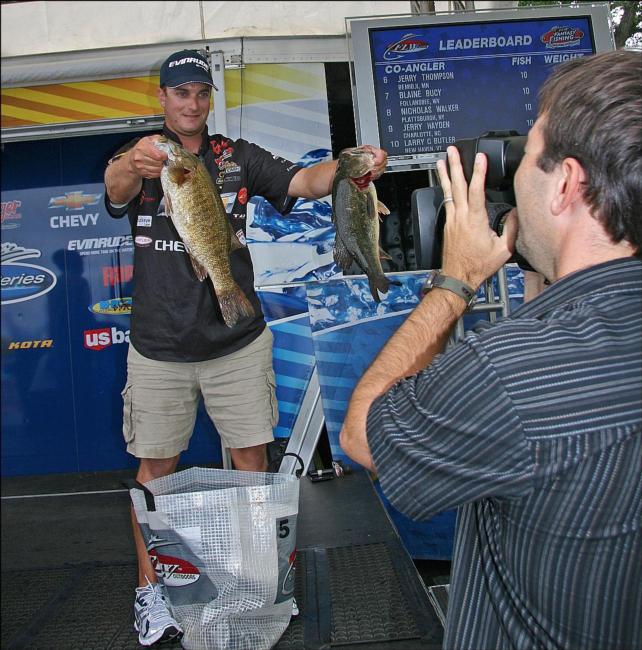
rod tip about 6 inches, though, before stopping to let the jig do its magic.
Gagliardi is working to train himself to return to his original position while reeling up extra line after every short sweep – or at least after every two – to avoid ending up with the rod too far back when a fish bites.
“Otherwise it’s easy to end up out of position for a good hookset,” he says.
Not always a drag
Although mop-style jigs clearly have made their biggest mark on the fishing world as slow-drag lures, that’s by no means their only application.
“Anywhere you’d throw a regular jig and want a big, bulky profile, you could throw a mop-style jig instead,” Gagliardi says.
In fact, he sometimes flips or pitches a Buckeye Mop Jig, and he might have a traditional flipping jig on one rod and a Mop Jig on another, letting the bass pick which profile they prefer. Of course, he’s most inclined to flip a Mop Jig at a lake such as Guntersville, where the bass are bigger on average.
“You might have to go a little heavier with the Mop Jig sometimes,” he notes. “The rate of fall can be really important some days, so if you’ve been fishing with a 1/2-ounce jig [with a silicone skirt], you might need a 5/8-ounce Mop Jig to get the same drop rate.”
The flip side of the same truth is that one of the best times to turn to a mop-style jig is when a slower fall rate seems to be the key to triggering more strikes. A slow fall is an inherent feature of a mop-style jig.
Makings of a mop-style jig
Skirt – The extra-long rubber strands in the skirt are so thick that fewer strands are normally used than are used for jigs with silicone skirts. However, some jigs of this style, including the Buckeye Mop Jig, include a mix of silicone strands to add to the color schemes, as the Living Rubber that Buckeye employs only comes in a few basic colors. Traditional homemade versions were normally all brown or black.
Line tie – A 60-degree bend from the line tie to the head provides back-end lift when the lure is dragged, adding to the action and helping the lure roll over rocks, which means fewer snags.
Head – The head must be wide so that the hook will point up whether the lure is being dragged across the bottom or at rest.
Hook – The hook must be big and stout, with plenty of bite because of the thickness of the rubber and the bulky trailers that typically get matched with these lures, and to accommodate the size of fish that normally take these jigs.
Skirt band – These jigs are always hand-tied with wire because the heavy rubber would not stay in place with only a rubber skirt band.
Trimming rubber skirts
Trimming rubber is purely a matter of personal preference, and it might depend on the lake or conditions. The skirts of Buckeye Mop Jigs are very long, and Gagliardi sometimes will fish them at full length. Other times he’ll trim a skirt, either to speed up the fall rate slightly or to keep the profile from being quite as imposing.
Buckeye mop jigs and their kin
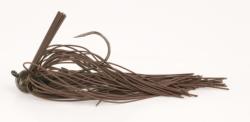
Buckeye Lures Football Mop Jig
1/2 and 3/4 ounce
five colors
$5 each
buckeyelures.com
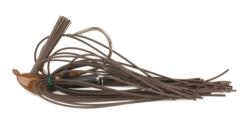
Buckeye Lures Mop Jig
four sizes, 1/4 to 5/8 ounce
nine colors
$5 each
buckeyelures.com
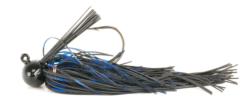
GMan G-Mop Jig
(two head styles are available)
three sizes, 3/4 to 1 1/2 ounce
completely customizable with a variety of head, silicone skirt and rubber skirt colors
$2.95 to $3.50 each
siebertoutdoors.com
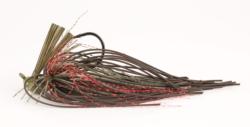
Skinny Bear Grizz Broom Flipping Jig
three sizes, 1/4 to 1/2 ounce
14 colors
$3.79 each
skinnybearbassjigs.com
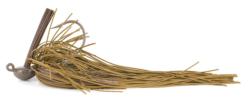
Talon Shibui Ookii Jig
3/8 and 1/2 ounce
more than 20 colors
flipping, football, grass and finesse models available in various sizes
$4.49 each
talonlures.com
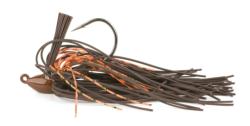
BOOYAH Alton Jones A-Jig
three sizes, 3/8 to 3/4 ounce
six colors
$3.87 each
booyahbaits.com
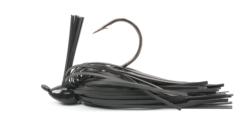
Tourney Jigs Flat Rubber Rocker Jig
four sizes, 1/4 to 3/4 ounce
five colors
$3.79 to $3.99 each
tourneyjigs.com
Mop Making 101
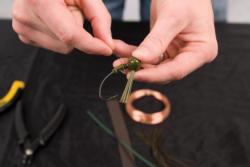
To make a mop-style jig, begin with a jighead that has a head wide enough to keep the hook pointed upward as you drag the lure across the bottom. Of course, the head must have a big, sharp hook too. Then follow these steps:
1. Before adding a rubber skirt to a jighead, wrap some thread around the shank of the hook and tie it off. The thread makes the surface less slick and easier to work with. Add extra wraps immediately below where you will tie the skirt to create a collar, which will cause the skirt to flare out more.
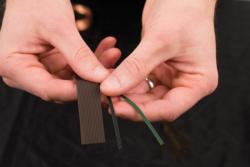 2. Form the skirt from 20 to 25 pieces of heavy round rubber, each cut about 7 inches long.
2. Form the skirt from 20 to 25 pieces of heavy round rubber, each cut about 7 inches long.
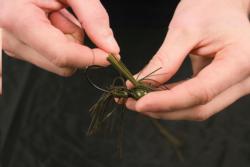 3. At press time, the heavy, round Living Rubber was available in four colors – brown, black, green-pumpkin and white. If you want to add color to a jig, begin with a layer of shorter strands of silicone in a color that complements the selected rubber. Tying the silicone on the inside puts the color highlights on the outside when the top strands are hanging down.
3. At press time, the heavy, round Living Rubber was available in four colors – brown, black, green-pumpkin and white. If you want to add color to a jig, begin with a layer of shorter strands of silicone in a color that complements the selected rubber. Tying the silicone on the inside puts the color highlights on the outside when the top strands are hanging down.
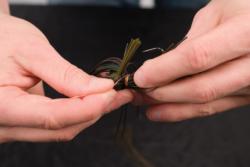 4. Secure the skirt strands tightly with wire (attach them with a rubber skirt collar first to hold them in place). Bind the strands off-center so that when the front ends lay back to form the outer skirt layer they will be slightly longer than the inner strands.
4. Secure the skirt strands tightly with wire (attach them with a rubber skirt collar first to hold them in place). Bind the strands off-center so that when the front ends lay back to form the outer skirt layer they will be slightly longer than the inner strands.